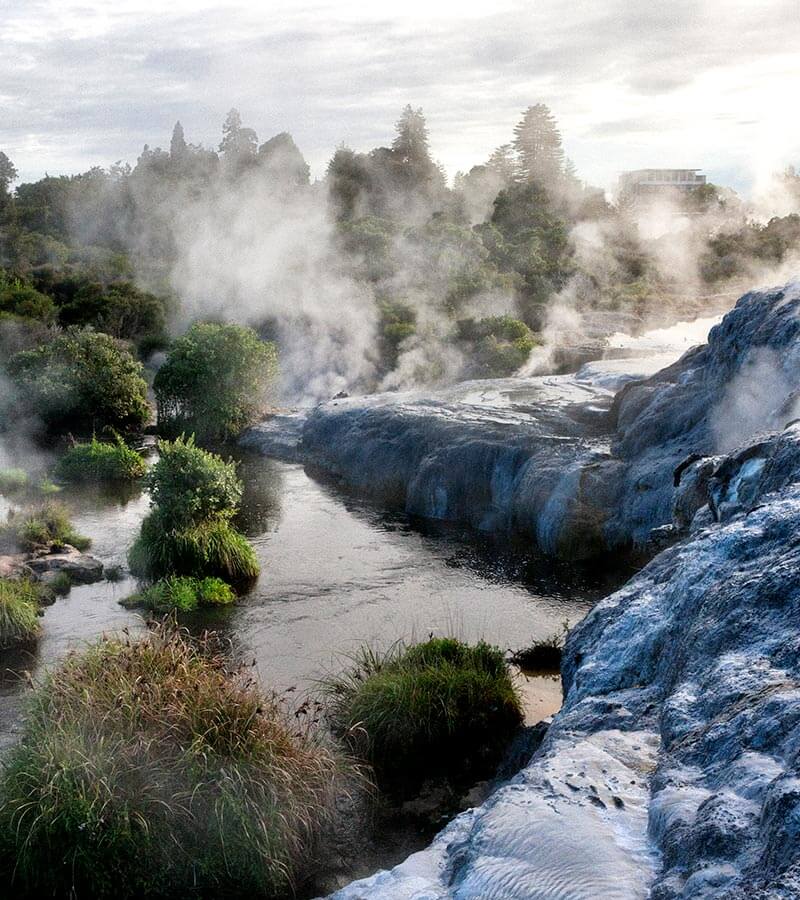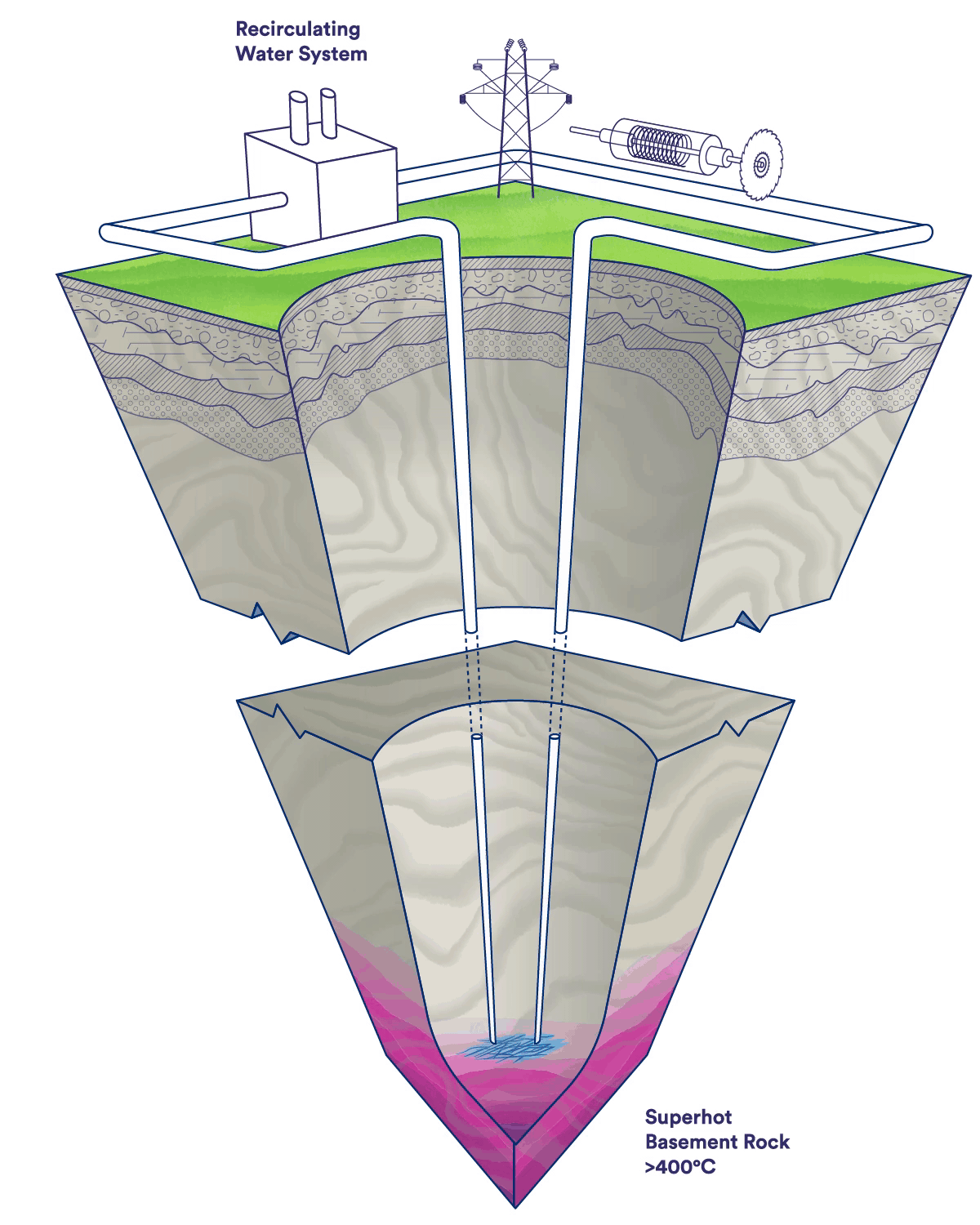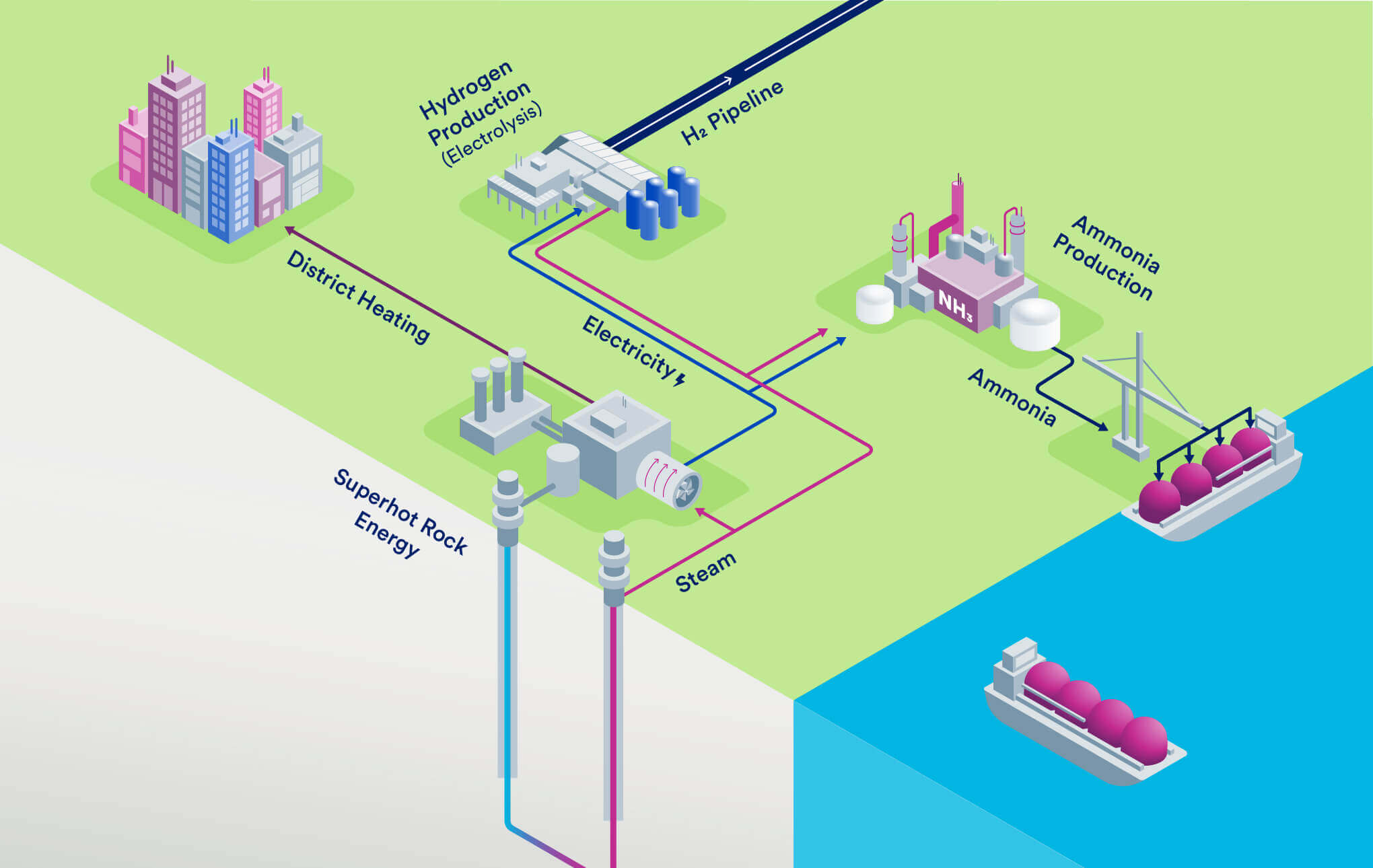Our Work
Superhot Rock Energy
An Energy Revolution in the Making
Superhot rock geothermal energy is a visionary energy source deserving of investment, and yet almost entirely unrecognized in the decarbonization debate. Technological innovation will allow us to access this energy, which has the potential to meet long-term demands for zero-carbon, always-on power, and can generate hydrogen for transportation fuel and other applications. Unlocking the potential of this energy source could expand our options and potentially carve a path forward to replace fossil fuels.

Latest updates in superhot rock energy
Sign up today to receive the latest content from CATF experts.
Superhot rock energy could support rapid global decarbonization
Rapid energy innovation is clearly needed now to meet the immense climate challenge. Vast amounts of reliable and dispatchable (always available) zero-carbon power will be needed to support the demand for access to energy by the growing global population.
At CATF, we envision a future where superhot rock energy could play a big role in transforming the energy system as a vital part of a prosperous, carbon-free global economy.
What is superhot rock energy?
Superhot rock geothermal energy is a visionary energy source deserving of investment, and yet almost entirely unrecognized in the decarbonization debate.
How does superhot rock energy work?
In a superhot rock system, water is injected deep into hot rock, heated, and returned to the Earth’s surface as steam that can be used to produce power in electric turbines or to generate hydrogen using a high temperature process.
Superhot rock energy could have a few distinct advantages over other energy sources. It is projected to be affordable, requiring little area to produce large amounts of energy (high energy density) due to the very large amount of energy that can be produced per well. Superhot rock is expected to produce five to ten times as much energy as the power produced from one of today’s commercial geothermal wells.
- Superhot rock geothermal “mines” deep at very high temperature and heat in the Earth’s crust. This contrasts with today’s small (~15 GW globally) commercial geothermal industry that typically depends on upwelling of hot groundwater at locations with high near surface heat.
- Superhot rock injects water into superhot dry crystalline rock by opening existing fractures at a depth where water is so hot it possesses properties of both liquids and gasses, allowing injected water to travel rapidly through existing rock fractures and gather very large volumes of heat energy.
- Production wells bring this steam energy to the surface to produce power in electric turbines and/or to generate hydrogen.

Superhot rock heat endowment and project map
This new, first-of-its-kind modeling tool highlights the vast energy potential of superhot rock geothermal energy.
Developed by Clean Air Task Force in collaboration with the University of Twente, the publicly accessible and transparent global model explores the case for commercializing superhot rock energy by estimating the technology’s energy potential around the world.
Our vision
For the last few years, CATF’s experts have researched this zero-carbon energy source and the new technologies needed to scale it worldwide in an affordable way. We are working to build momentum behind this dispatchable, energy-dense resource, and to add it to the global decarbonization debate as a long-term strategy for meeting energy demand growth in a world without fossil fuels.
CATF’s vision is to rapidly scale superhot rock from demonstration to initial commercialization in this decade, and with parallel development of deep drilling methods, scale to “geothermal everywhere” in the 2030s. Superhot rock energy can be demonstrated today in areas with high near-surface heat, using existing technology, while adopting strategies and innovations from unconventional oil and gas development, such as intensive drilling campaigns, to accelerate deployment, scale and adoption. Future energy drilling innovations could allow accessing the superhot conditions in much deeper wells in mid-continental regions currently without geothermal resources.
The value of superhot rock energy
- Competitive power
- Endless Earth energy resource
- Dispatchable, meaning always on, baseload power
- Energy dense, high energy with a small surface footprint
- No fuel cost
- Zero greenhouse gases
- Pivots fossil energy to geothermal across the globe
- Potential to repower fossil power plants
- Generate carbon-free hydrogen without carbon as a transportation fuel
- Accessible worldwide with super deep drilling innovation
- Significant engineering advancements required but does not depend on scientific breakthroughs
- Energy security and modernization
What are the opportunities and challenges?
Key innovations are needed to rapidly deploy superhot rock energy, including deep drilling and heat reservoir development. While technically challenging, these are achievable innovations that could be quickly developed with adequate funding. One key challenge is developing heat reservoirs that injected water can circulate through. This will require methods to identify existing fractures that can be stimulated and injected without incident. Research is underway in laboratories worldwide to develop methods for reservoir creation in superhot rock.
Efforts are underway to develop the technologies needed to access superhot rock energy, such as high-temperature cement and drills capable of moving quickly through hard rock. National labs in multiple countries, innovative drilling startups, established oil and gas companies looking to pivot to geothermal, and private research institutions are all playing a role in this work.
Superhot Rock Energy Glossary
This glossary provides a foundational set of terms about geothermal systems and some of the necessary components for a successful geothermal project. It focuses on superhot rock energy, a high-temperature form of geothermal energy.

Related resources
Meet our experts in superhot rock energy
If you have questions or are interested in learning more about our Superhot Rock Energy program and some of the latest innovations in this space or would like to support our efforts in advancing this new technology, contact Program Director Terra Rogers.
Superhot rock energy FAQs
What is superhot rock energy and what are its benefits?
Superhot rock energy is a transformative new zero-carbon, always-available energy source that could be used for power, heat, hydrogen production, and industrial process energy. It has the potential to be economically competitive with most other zero-carbon energy sources and could be deployed rapidly in much of the world. It could potentially repower or replace many existing fossil fuel energy facilities and strengthen energy security by providing a local energy source – all with a relatively small environmental footprint.
Superhot rock energy is a form of geothermal energy; a consistent, dispatchable “baseload” source. Unlike other renewable energy resources, geothermal energy is consistently available and doesn’t require the use of battery storage, nor does it need to be backed up by a baseload power source such as fossil fuels. Using deep drilling technology, we could access superhot rock energy worldwide – increasing energy access, energy equity, and energy security.
What is geothermal energy and how does it work?
Geothermal energy taps into the energy beneath our feet. Our planet’s interior contains naturally occurring heat, which spreads through conduction and convection up to the Earth’s surface. In “shallow heat” regions where concentrated heat is available near the surface, such as Italy, Turkey, or the Western U.S., conventional, or hydrothermal, geothermal energy works by drilling into reservoirs of heated groundwater and bringing steam to the surface to provide hot water to heat buildings, and to turn turbines to produce electricity. Where heat is deep, accessing hot water requires drilling farther into the Earth’s crust. In many areas, heat exists without a source of water. In those regions, water can be sent down to circulate through hot rock. The heat turns the water into steam, which is then brought to the surface. There are many emerging innovations that are looking to tap into these regions for heating, cooling, and the production of electricity.
How is superhot rock energy different from conventional geothermal energy?
Conventional geothermal power is produced from naturally heated groundwater close to the surface and generally at temperatures of 150-200°C. Superhot rock energy will be produced by drilling into hotter rock at deeper depths (>400°C), injecting and circulating water through the rock to heat it to very high temperatures, and then pumping it back to the surface to a generation plant. With successful deep drilling innovation, superhot rock energy could be produced anywhere in the world and will not be limited to regions with shallow heat and groundwater.
Water above 400°C is in the “superhot” (supercritical) state, which is much more energy-dense and can circulate more efficiently than lower-temperature water. These properties will allow superhot rock energy systems to produce an estimated 5-10x the energy of conventional geothermal systems – giving it the potential to be competitive with today’s costs for power. This high energy potential has been demonstrated in Iceland, where the Iceland Deep Drilling Project’s Krafla borehole produced superhot water at 452°C and an estimated 36 megawatts of energy (MWe) production potential. In comparison, a conventional geothermal project produces about 7-8 MWe per well.
Though humans have been using geothermal energy for over 100 years, (starting in Tuscany, Italy, in 1904) it’s only recently that technological advancements have made superhot rock energy a possibility. As of 2018, there were only 15 GW of conventional geothermal power in the world and geothermal accounted for less than 0.5% of total global electricity production. Because of its dramatically higher energy capacity and “geothermal everywhere” potential, superhot rock energy can be a much larger source of power, potentially on a terawatt scale.
Where can superhot rock energy be developed?
The temperatures required to create superhot rock energy have already been accessed in regions where the earth’s heat is near the surface, such as Iceland, Italy, Turkey, or the Western U.S. These shallow-heat regions will likely be the first regions where superhot rock energy will be developed. However, superhot rock has the potential to be deployed on a global scale, almost anywhere in the world. Achieving “geothermal everywhere” will require innovative drilling technologies that can cost-effectively reach superhot resources at depths of up to 15 km/~9 mi (compared to depths of 7 km/~4 mi accessible through current drilling methods). There are several companies currently working to push the limits of today’s drilling, and the innovations needed are engineering innovations rather than major scientific breakthroughs.
View the superhot rock project map.
How much will it cost to generate superhot rock energy?
Clean Air Task Force commissioned Hot Rock Energy Research Organization (HERO) and LucidCatalyst to estimate the levelized cost of energy for future mature (“nth of a kind”) superhot rock power plants. Levelized cost of energy (LCOE) is a standard measurement in the energy industry that is used to compare the cost of energy sources and is calculated by dividing the lifetime cost of a power plant by the total energy produced by that plant. Results suggest that mature superhot rock will be competitive at $20-35 per MWh, compared to $40 per MWh, the current U.S. market price for electricity.
Does superhot rock energy produce CO₂?
The Earth’s heat is a carbon-free energy source. Unlike fossil fuel power, no direct carbon dioxide (CO₂) will be emitted in the process of generating power in dry rock. Superhot rock also represents an advantage over commercial hydrothermal geothermal systems, which harvest hydrothermal fluids that sometimes contain carbon dioxide. Because superhot rock energy will work in hot dry rock, which is highly unlikely to contain free CO₂, it’s envisioned as an entirely carbon-free form of energy.
Is superhot rock energy renewable, or does it risk depleting the Earth’s heat?
Superhot rock energy does not risk depleting the Earth’s heat. On human timescales, superhot rock energy is endless, the ultimate renewable resource. One estimate suggests that 0.1% of the Earth’s heat could meet our world’s energy needs for 2 million years. Scientists predict that the Earth will continue to produce geothermal heat for billions of years, and the amount of energy needed by humans is tiny compared to the energy produced. Human geothermal use will not affect the Earth’s heat in any meaningful way.
How can superhot rock energy help produce hydrogen?
Superhot rock energy is well-suited to generate low-carbon hydrogen, which can be used to decarbonize hard-to-abate sectors such as heavy transport and industry. There are multiple factors that make superhot rock energy and hydrogen production a good match.
First, the intense heat and power that superhot rock generates could be used for hydrogen production. Superhot rock energy generates electricity, which can be used for hydrogen generation via high temperature electrolysis. The superheated steam could increase the efficiency of electrolytic hydrogen production in solid oxide electrolyzers.
Additionally, superhot rock energy is a source of inexhaustible, firm energy, operating around the clock regardless of weather or other external factors. This energy production profile is what hydrogen plants need to operate 24 hours a day.
A forthcoming Lucid Catalyst analysis produced for Clean Air Task Force estimates that superhot rock energy could produce hydrogen cost-competitively, though hydrogen production from superhot rock energy still needs to be demonstrated.

Is superhot rock energy the same thing as supercritical geothermal energy?
“Supercritical” is a technical term that refers to water that has heat at or above 400°C and pressure at or above 22 MPa. “Superhot” is a less technical term that refers to water at or above about 400°C, regardless of pressure, as well as to other very hot fluids.
What are engineered geothermal systems (EGS) and hot dry rock systems, and how do they relate to superhot rock energy?
Geothermal energy typically requires a heat source (rock), water, and permeable rock so that the water can circulate through it and absorb the heat. In geothermal systems where hot rock does not contain a natural source of water and permeability, permeability must be created. Engineered geothermal systems (EGS) are geothermal systems that do not use natural hydrothermal water. They have also been referred to as “hot dry rock systems.”
Superhot rock energy is a subset of EGS that accesses much hotter temperatures (above 400°C) than EGS has historically accessed. “Direct-contact” superhot rock works by pumping water down one pipe into hot rock, where it circulates through tiny fractures in the rock to absorb heat, and then rises up a second pipe to the surface. An alternative to circulating water through fractures may be closed-loop injection systems, which heat water inside deep drilled conduits or pipes through the hot rock at depth.
What’s needed to speed the development of superhot rock energy?
Key innovations are needed to unlock the widespread deployment of superhot rock energy. These include developing tools that work in the extreme conditions of superhot rock, new well construction materials, new methods designed to function in deep heat, new ultra-deep drilling methods, and new methods for creating reservoirs. While technically challenging, these advancements are achievable, and could be developed relatively quickly with aggressive funding—as has been the case for many other energy technologies.
An intensive drilling and resource development program by well-funded consortia could provide the knowledge and innovation needed to develop and rapidly commercialize superhot rock around the world. Using the subsurface expertise and capital resources from the oil and gas industry could speed up the rapid development of superhot rock energy systems.
Global regulatory needs and agency technical staffing need to be anticipated early on to provide a roadmap for superhot rock energy developers while generating confidence among policymakers and the public that these projects will be safe and environmentally-friendly.
What advanced drilling technologies are being developed?
Drilling deep into hard rock causes drill bits to wear out quickly. Emerging innovations like hammer drilling, hybrid PDC/particle drilling, and contactless energy drilling solve this problem by finding other ways to drill.
- Plasma drilling, such as the Plasmabit drill under development by GA Drilling, works by emitting a stream of plasma—extreme heat energy formed as electrons are stripped from atoms using a high-voltage electric current.
- Millimeter wave drilling vaporizes rock and is under development by Quaise in Houston, TX, in collaboration with Oak Ridge National Laboratory.
- The PDC bit has been proven to increase rate of penetration and reduce drill times significantly in the crystalline rock at FORGE.
- Other developing technologies include hybrid PDC/particle drilling, projectile drilling, hybrid laser drilling, and mudhammer drilling.
What are the next steps toward commercialization of superhot rock technologies?
Numerous drilling projects have drilled into superhot rock. Iceland and Italy have both hosted international R&D projects and more pilot demonstrations are in planning stages in regions around the world where superhot conditions are near-surface. Once these pilot demonstrations successfully produce energy-dense superhot water at the surface, and ultimately create electricity, the next step is to demonstrate superhot rock energy at commercial scale (e.g., 100+ MW) in locations with a wide range of geologies and depths to heat. In the final stage, superhot rock energy will expand to full global-scale commercialization.
Each of these steps will involve tremendous learning-by-doing and will also rely on laboratory research into reservoir creation, drilling, and surface infrastructure. Public and private investments will be needed in the early stages of commercialization to provide drilling campaign incentives and to enhance cross-pollination among international projects. Ultimately, commercializing superhot rock energy will require resources from the geothermal industry, governments, national laboratories, academic institutions, and the existing energy industry.





















